John Marshall’s Favorite White Hybrid Grapes
I was invited to a wedding some years ago now, outside Phoenix, Arizona. Since I arrived in Arizona a day early, I was interested to see what the famous varieties of Europe might do in the high arid climes above Phoenix. The climate is so unlike California or Bordeaux I was hoping to find some surprises but was disappointed that most of the wines were imported directly from California. I found an excellent locally grown Finlander, a delightful Petite Syrah and a unique blended blush but had to make do mostly with cookie cutter Chardonnays from California.
On the way home, however I had a completely different wine experience in the Western Nebraska grasslands visiting wineries in unexpected places. First I stopped at Prairie Vine Vineyards in a brightly colored store front in Mitchell, just a few miles from Wyoming. I scanned their wine list and realized I was not going to have to ask my usual first question, ‘Which of these wines are grown here?” It was almost entirely Swenson and University of Minnesota Hybrids with a few uncommon labrusca hybrids thrown in. These were indeed prairie wines made from ‘Prairie Vines.”
I asked to try Elmer’s wonderful old hybrid St. Pepin. It has proven to be marginally hardy in Minnesota, but in Iowa, Illinois and it turns out, the high prairies of Western Nebraska it is rock solid reliable. It was an epiphany. A bright clarity, a wonderful flowery aroma that did not need oak to give it fragrance; fruity and crisp with a bit of acidity and a touch of sweetness in the finish. I was astonished to realize this was easily the best white wine I had tasted on my trip.
As I travelled east across Nebraska toward home I visited wineries along the way. By the end of th journey I saw the northland’s collection of white wine grapes in a different light. They may be unlike California but they are delicious, varied in character, with enormous customer appeal.
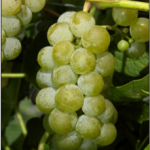 BRIANNA — An old Elmer Swenson Hybrid the potential of which was first recognized by Ed Swanson of Cuthills Winery in Nebraska. Its hardiness seems in question as some growers in southern Minnesota have cold injury, but it is known to be grown in North Dakota and even Manitoba. Brianna produces a white wine ripening early in September, very fruity with notable grapefruit flavors. When overly ripe, it can take on a strong pineapple flavor. When picked early, it produces a rich fruity wine often used for blending. Originally grown as a seeded table grape. The clusters are smallish and quite tight.
BRIANNA — An old Elmer Swenson Hybrid the potential of which was first recognized by Ed Swanson of Cuthills Winery in Nebraska. Its hardiness seems in question as some growers in southern Minnesota have cold injury, but it is known to be grown in North Dakota and even Manitoba. Brianna produces a white wine ripening early in September, very fruity with notable grapefruit flavors. When overly ripe, it can take on a strong pineapple flavor. When picked early, it produces a rich fruity wine often used for blending. Originally grown as a seeded table grape. The clusters are smallish and quite tight.
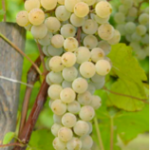 ST. PEPIN — An early Elmer Swenson white wine grape with pleasingly moderate vigor and an open growth habit. Ripens in mid-September in Minnesota with a nice sugar/acid balance. The wine is light with a flowery aroma. St. Pepin’s pleasing acidity reminds me of Pinot Gris. Elmer’s hybrids are held in high esteem in Nebraska, but St. Pepin is regarded as one of his best. Main drawback is that it is pistilate and requires cross-pollination to be successful.
ST. PEPIN — An early Elmer Swenson white wine grape with pleasingly moderate vigor and an open growth habit. Ripens in mid-September in Minnesota with a nice sugar/acid balance. The wine is light with a flowery aroma. St. Pepin’s pleasing acidity reminds me of Pinot Gris. Elmer’s hybrids are held in high esteem in Nebraska, but St. Pepin is regarded as one of his best. Main drawback is that it is pistilate and requires cross-pollination to be successful.
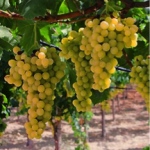 EDELWEISS — Elmer originally released this grape through the University of Minnesota as an early ripening table variety, but it has found a place for itself as a white wine grape instead. If allowed to become fully ripe, it takes on an overpowering Labrusca flavor and aroma that is unpleasant. However, when picked early and made in a light style, Edelweiss has a delicious light, fruity flavor and pleasing aroma. In fact it is the wine most in demand in Nebraska liquor stores, beating out all the California Chardonnays, Australian whites or famed French blended whites. Its huge popularity, hardiness, reliability and excellent cultural characteristics suggests Edelweiss needs to be grown much more widely than it is.
EDELWEISS — Elmer originally released this grape through the University of Minnesota as an early ripening table variety, but it has found a place for itself as a white wine grape instead. If allowed to become fully ripe, it takes on an overpowering Labrusca flavor and aroma that is unpleasant. However, when picked early and made in a light style, Edelweiss has a delicious light, fruity flavor and pleasing aroma. In fact it is the wine most in demand in Nebraska liquor stores, beating out all the California Chardonnays, Australian whites or famed French blended whites. Its huge popularity, hardiness, reliability and excellent cultural characteristics suggests Edelweiss needs to be grown much more widely than it is.
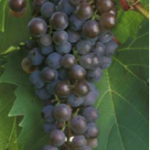 FRONTENAC GRIS — A University of Minnesota Hybrid that is a color mutation of the original red Frontenac. It is does not produce a true white wine as some color elements remain and presses out to copper or salmon color, rich with apricot and peach flavors. Like its parent, Frontenac Gris ripens with high acidity and needs to be sweetened to be palatable. This brings out the remarkable flavors that are the strengths of this grape. We find that pulling the skins off prematurely in fermentation and treating the juice with calcium carbonate reduces the copper color, but also reduces the fruit flavors that set this wine apart. While it is unlike a typical white wine in appearance and flavor, it has great customer appeal. We prefer to emphasize this wine’s unconventional characteristics rather than attempting to mute or reduce them.
FRONTENAC GRIS — A University of Minnesota Hybrid that is a color mutation of the original red Frontenac. It is does not produce a true white wine as some color elements remain and presses out to copper or salmon color, rich with apricot and peach flavors. Like its parent, Frontenac Gris ripens with high acidity and needs to be sweetened to be palatable. This brings out the remarkable flavors that are the strengths of this grape. We find that pulling the skins off prematurely in fermentation and treating the juice with calcium carbonate reduces the copper color, but also reduces the fruit flavors that set this wine apart. While it is unlike a typical white wine in appearance and flavor, it has great customer appeal. We prefer to emphasize this wine’s unconventional characteristics rather than attempting to mute or reduce them.
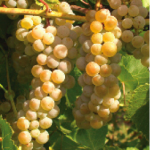 PRAIRIE STAR — This Elmer Swenson Hybrid is capable of producing excellent, crisp, clean, dry white wines in the California tradition and has been mistaken for Sauvignon Blanc. It is vigorous growing with few disease problems, but in some areas has chronic pollination problems that leaves partial clusters, shot berries and usually a very small crop. Fertilization and environmental causes are being explored and once the solution is identified it would be of value for the crisp, neutral full-bodied white wine it is capable of producing.
PRAIRIE STAR — This Elmer Swenson Hybrid is capable of producing excellent, crisp, clean, dry white wines in the California tradition and has been mistaken for Sauvignon Blanc. It is vigorous growing with few disease problems, but in some areas has chronic pollination problems that leaves partial clusters, shot berries and usually a very small crop. Fertilization and environmental causes are being explored and once the solution is identified it would be of value for the crisp, neutral full-bodied white wine it is capable of producing.
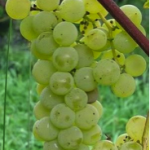 LOUISE SWENSON — Named for the breeder’s wife and usually just called ‘Louise” it is a pretty, delicate, slow growing vine. Louise Swenson was named at the same time as Prairie Star to be blended with it. It has a flowery aroma and subtle honey flavors. It is extremely disease resistant and rarely needs to be sprayed, but is clearly low on vigor. Many growers grow it on their richest soils and space the vines at 6’ apart or even closer. The wine tends to be light and the flavors very subtle. In addition, it makes an excellent ‘quality” blending element and Louise wines have won awards as 100% varietals as well. Also, a good seeded table grape.
LOUISE SWENSON — Named for the breeder’s wife and usually just called ‘Louise” it is a pretty, delicate, slow growing vine. Louise Swenson was named at the same time as Prairie Star to be blended with it. It has a flowery aroma and subtle honey flavors. It is extremely disease resistant and rarely needs to be sprayed, but is clearly low on vigor. Many growers grow it on their richest soils and space the vines at 6’ apart or even closer. The wine tends to be light and the flavors very subtle. In addition, it makes an excellent ‘quality” blending element and Louise wines have won awards as 100% varietals as well. Also, a good seeded table grape.
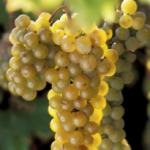 LA CRESCENT — A University of Minnesota hybrid filled with tropical fruit flavors and aromas. Not good as a dry wine. Like Frontenac Gris, the acidity is high when not balanced with sugar. When made modestly sweet, the flavors and aromas emerge. This semi dry style La Crescent may well be the best of the new white wine hybrids that are emerging.
LA CRESCENT — A University of Minnesota hybrid filled with tropical fruit flavors and aromas. Not good as a dry wine. Like Frontenac Gris, the acidity is high when not balanced with sugar. When made modestly sweet, the flavors and aromas emerge. This semi dry style La Crescent may well be the best of the new white wine hybrids that are emerging.
These new hybrids have not only made grape growing feasible in areas where it is was previously marginal and pushed vinicultural limits further north than ever before, they are also introducing to the public a new class of wine grape with flavors and aromas that cannot be found in a liquor store.
See related story: John Marshall’s Favorite Red Wine Grapes
John is a regular columnist in Midwest Wine Press and a vineyard and winery owner in Lake City, Minnesota. See Great River Vineyard and Nursery for more information.


This is a very good overview of the white wine grape varieties available to Northern growers. I think most of us in the industry would agree that the quality of the cold hardy white wine varieties is way ahead of the hardy red wine varieties(although hopefully this will change in the coming years!). Wine drinkers accustomed to only vinifera varieties would find many of our Northern white wines quite delightful. And a number of them, such as Frontenac Gris with its pleasant apricot/peach notes, have flavors that, as John says, “cannot be found in a liquor store”. That is a strength to build upon, for sure
What about Frontenac Blanc?
Good point, but FB is hard to find. Any suggestions or recommendations for Frontenac Blanc?
Hi Adam
Check out North east vine supply
Don’t forget about Traminette!! Indiana’s Signature Grape isn’t as new as some of the grapes mentioned above. But all of these make exceptional wines. And in Indiana, we’ve found people are very willing to try local grapes!
In Wisconsin we see that not only are people willing to try locally grown wine they are seeking it out! Establishing a signature grape is a grower issue. Wisconsin wineries are currently capable of producing salable grape based wines derived from multiple sources and locally grown fruit based wines to fill this growing demand. To John’s point of the article the white varitals already available to northern growers have as he states “enormous customer appeal”. Growers need to commit to larger plantings of these single varitals and deliver quality grapes, year over year to the winemaker in order to move the industry forward.
I live in Poland and i have over 55 grape species .I have had Praire Star making wine and it is quite predictable.I see similarity to Vidal ,with thick skin and wasp and birds dosen’t like it.In clay soil it has very slow growth ,and has more bunches than leaves.This is good material for ice wine or for straw wines..In dry weather condition you can see forming raisins ,however in my climate difficult to achive. The most sucessful Elmer Swenson grape in my country is is Adalmiina I see similarity to Seval Blanc with quite high extract,however my most intriguing wine is Louse Swenson it has low dry extract I see similarity to my Sauvignon Blanc-the colder weather the more aromatic sometimes quite surprising like tangerines,gooseberry taste .It dosent like sun .Oescola muscat is quite similar the colder weather the more aromatic.In hot summer it has very high sugars and labruska flavour.I have wanted to have Tramintte but this wine was unavailable in my country ,not sure how it is?